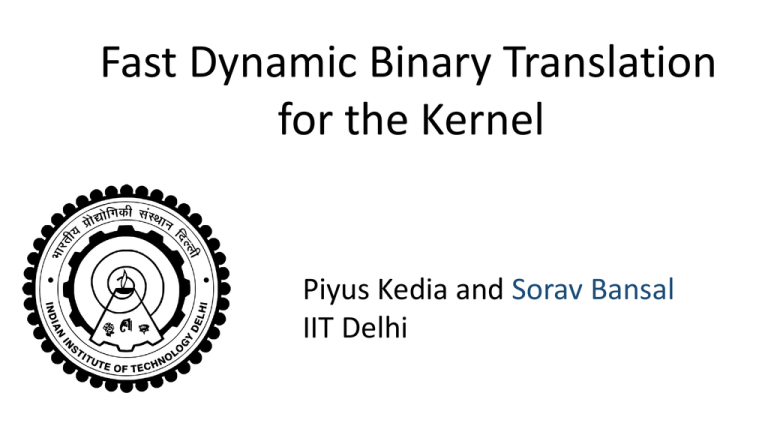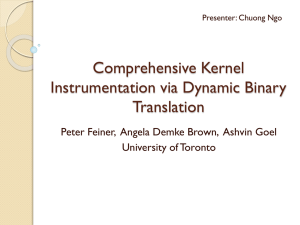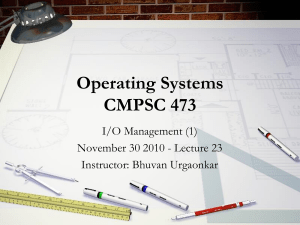talk-PPTX
advertisement

Fast Dynamic Binary Translation
for the Kernel
Piyus Kedia and Sorav Bansal
IIT Delhi
Applications of Dynamic Binary Translation
(DBT)
OS Virtualization
Testing and Verification of Compiled Programs
Profiling and Debugging
Software Fault Isolation
Dynamic Optimizations
Program Shepherding
… and more
A Short Introduction to
Dynamic Binary Translation (DBT)
Start
Dispatcher
Block terminates
with branch to
dispatcher
instruction
Native code
Translate Block
Execute Block
Code Cache
Start
Native code
Dispatcher
cached?
yes
Execute from
Code Cache
no
Translate Block
Store in code cache
DBT Overheads
• User-level DBT well understood
• Near-native performance for application-level workloads
• DBT for the Kernel requires more mechanisms
• Efficiently handling exceptions and interrupts
• Case studies:
• VMware’s Software Virtualization
• DynamoRio-Kernel (DRK) [ASPLOS ’12]
Interposition on Starting (Entry) Points
Start
Start
Native code
Dispatcher
cached?
yes
Execute from
Code Cache
no
Translate Block
Store in code cache
IDT now points to the dispatcher
Interrupt Descriptor Table
Native code
Dispatcher
cached?
yes
Execute from
Code Cache
no
Translate Block
Store in code cache
What does the dispatcher do?
Before transferring control to the code cache, the dispatcher:
1. Converts interrupt state on stack to native values (e.g., PC)
What does the dispatcher do?
SP
Guest Stack
Guest Stack
CS register
PC
Flags
CS register
Native PC
Flags
SP
Before transferring control to the code cache, the dispatcher:
1. Converts interrupt state on stack to native values (e.g., PC)
What does the dispatcher do?
Before transferring control to the code cache, the dispatcher:
1. Converts interrupt state on stack to native values (e.g., PC)
2. Emulates Precise Exceptions
What does the dispatcher do?
Precise Exceptions
Before the execution of an exception handler, all instructions up to the
executing instruction should have executed, and everything afterwards
must not have executed.
Before transferring control to the code cache, the dispatcher:
1. Converts interrupt state on stack to native values (e.g., PC)
2. Emulates Precise Exceptions
What does the dispatcher do?
Precise Exceptions
add
sub
load
Executed
store
push mov
pop
Exception handler
executes
Before transferring control to the code cache, the dispatcher:
1. Converts interrupt state on stack to native values (e.g., PC)
2. Emulates Precise Exceptions
• Rolls back partially executed translations
What does the dispatcher do?
Before transferring control to the code cache, the dispatcher:
1. Converts interrupt state on stack to native values (e.g., PC)
2. Emulates Precise Exceptions
• Rollback partially executed translations
3. Emulates Precise Interrupts
What does the dispatcher do?
Precise Interrupts
add
sub
load
Executed
store
push mov
pop
Interrupt handler
executes
Before transferring control to the code cache, the dispatcher:
1. Converts interrupt state on stack to native values (e.g., PC)
2. Emulates Precise Exceptions
• Rollback partially executed translations
3. Emulates Precise Interrupts
• Delays interrupt delivery till start of next native instruction
Effect on Performance
Applications with high interrupt and exception activity
exhibit large DBT overheads
Data from “Comparison of Software and Hardware Techniques for x86 Virtualization”
K. Adams, O. Agesen, VMware, ASPLOS 2006.
VMware’s Software Virtualization Overheads
benchmarks
Percentage Overhead over Native
140
123.48
120
100
80
60
40
27.11
20
2.9
0
SpecInt
kernel-compile
apache
Data from “Comparison of Software and Hardware Techniques for x86 Virtualization”
K. Adams, O. Agesen, VMware, ASPLOS 2006.
VMware’s Software Virtualization Overheads
Percentage Overhead over Native
m-benchmarks
benchmarks
700
603.44
600
500
400
300
200
123.48
100
2.9
57.81
27.11
91.68
0
SpecInt
kernel-compile
apache
2D-graphics
large-RAM
forkwait
Data from “Comparison of Software and Hardware Techniques for x86 Virtualization”
K. Adams, O. Agesen, VMware, ASPLOS 2006.
Percentage Overhead over Native
VMware’s Software Virtualization Overheads
m-benchmarks
benchmarks
900
nano-benchmarks
853.72
800
700
603.44
600
500
400
262.54
300
200
100
0
123.48
2.9
27.11
57.81
91.68
Data from “Comprehensive Kernel Instrumentation via Dynamic Binary Translation”
P. Feiner, A.D. Brown, A. Goel, U. Toronto, ASPLOS 2012.
Dynamo-Rio Kernel (DRK) Overheads
Percentage Overhead over Native
400
351.85
350
325.37
300
250
212.3
184.13
200
150
100
44.44
50
0
fileserver
webserver
webproxy
varmail
apachebench
DRK vs BTKernel
Percentage Overhead over Native
400
351.85
350
325.37
300
250
212.3
184.13
200
150
100
44.44
50
0
0.36
fileserver
2.19
2.44
webserver
webproxy
10.6
varmail
0.42
apachebench
Fully Transparent Execution is not required
• The OS kernel rarely relies on precise exceptions
• The OS kernel rarely relies on precise interrupts
• The OS kernel seldom inspects the PC address pushed on stack. It is
only used at the time of returning from interrupt using the iret
instruction.
Faster Execution is Possible
• Leave code cache addresses in kernel stacks.
• An interrupt/exception directly jumps into the code cache, bypassing the
dispatcher.
• Allow imprecise interrupts and exceptions.
• Handle special cases specially.
IDT now points to the code cache
Interrupt Descriptor Table
Native code
Dispatcher
cached?
yes
Execute from
Code Cache
no
Translate Block
Store in code cache
IDT now points to the code cache
Interrupt Descriptor Table
Execute from
Code Cache
Store in code cache
yes
cached?
Dispatcher
no
Translate Block
Native code
Correctness Concerns
1. Read / Write of the interrupted PC address on stack will return
incorrect values.
• Fortunately, this is rare in practice and can be handled specially
Read of an interrupted PC address
Examples:
Guest Stack
1. Exception Tables in Linux page fault
handler
CS register
translated PC
Flags
SP
load addr
Exception Tables in Linux
• Page faults are allowed in certain functions
• e.g., copy_from_user(), copy_to_user().
• An exception table is constructed at compile time
• contains the range of PC addresses that are allowed to page fault.
• At runtime, the faulting PC value is compared against the exception
table
• Panic only if PC not present in exception table
Read of an Interrupted PC address
Problem:
The faulting PC value is now a codecache address.
Guest Stack
CS register
translated PC
Flags
SP
Solution:
Dispatcher adds potentially faulting code
cache addresses to the exception table
load addr
Read of an Interrupted PC address
Examples:
Guest Stack
1. Exception Tables in Linux
CS register
translated PC
Flags
SP
2. MS Windows NT Structured Exception
Handling
__try / __except constructs in C/C++
load addr
__try / __except blocks in MS Windows NT
Syntax:
__try {
<potentially faulting code>
} __except {
<fault handler>
}
Example Usage:
__try {
copy_from_user();
} __except {
signal_process()
}
Also implemented using exception tables in the Windows kernel
More examples in paper
In our experience, all such cases can be nicely handled!
Correctness Concerns
1. Read / Write of the faulting PC address on stack will return incorrect
values.
2. Code-cache addresses will now live in kernel stacks.
• What if code-cache addresses become invalid?
Code Cache Addresses can now live in Kernel
Data Structures
Thread 1
Stack
CS register
translated PC
Flags
Context Switch
SP
Code Cache
Thread 2
Stack
SP
Code Cache Addresses can now live in Kernel
Data Structures
• Disallow Cache Replacement
• Code Cache of around 10MB suffices for Linux
• Do not move or modify code cache blocks, once they are created
• Ensures that a code cache address remains valid for the execution lifetime
• If the code cache gets full, switchoff and switch-back on the translator
• Switchoff implemented by reverting to original IDT and other entry points.
• This results in effectively flushing the code cache and starting afresh
Dynamic Switchon / Switchoff
• Replace all entry points with shadow / original values
• e.g., for switchoff, replace shadow interrupt descriptor table with original
• Iterate over the kernel’s list of threads
• Identify PC values in thread stacks and convert them to code cache / native
values
• Translator reboot (switchoff followed by switchon) flushes the code
cache
Correctness Concerns
1. Read / Write of the faulting PC address on stack will return incorrect
values.
2. Code-cache addresses will now live in kernel stacks. What if codecache addresses become invalid?
3. Imprecise Interrupts and Exceptions.
Imprecise Exceptions and Interrupts
Interestingly, an OS kernel typically never depends on precise
exceptions and interrupts.
Reentrancy and Concurrency
Direct entries into the code cache introduce new reentrancy
and concurrency issues
Detailed discussion in the paper.
Optimizations that worked
• L1 cache-aware Code Cache Layout
• Function call/return optimization
Code Cache Layout for Direct Branch Chaining
Dispatcher
Code Cache
Edge Cache
Edge code for branching
to dispatcher
Edge code:
• executed only once, on the first execution of the block.
• However, shares the same cache lines as all other code.
Allocate edge code from a separate memory pool for better cache locality.
Function call/return optimization
Use identity translations for ‘call’ and ‘ret’ instructions
instead of treating ‘ret’ as another indirect branch.
Involves careful handling of call instructions with indirect targets
(discussed in the paper)
Experiments
• BTKernel Performance vs. Native
• BTKernel Statistics
• Experience with some applications
Apache 1, 2, 4, 8 and 12 processors
Throughput (MBps)
14
12
10
8
6
4
2
0
1
2
4
8
Number of Processors
Native
BTKernel
BTKernel-no-callret
Higher is better
12
Thousands
Throughput (ops/s)
Fileserver 1, 4, 8, 12 processors
40
35
30
25
20
15
10
5
0
1
4
8
Number of Processors
Native
BTKernel
BTKernel-no-callret
Higher is better
12
Time (Microseconds)
lmbench fork operations
1400
1200
1000
800
600
400
200
0
execve
exit
lmbench microbenchmark
Native
BTKernel
BTKernel-no-callret
Lower is better
sh
Number of Dispatcher Exits
Apache
Linux Build
Without call/ret
optimization
Instructions
Dispatcher
Exits
56 b
7m
570 b
72 m
m = million
b = billion
With call/ret optimization
Instructions
59 b
Dispatcher
Exits
125
590 b
33059
Applications
• We implemented Shadow Memory for a Linux guest
• Identifies the CPU-private (read/write) and CPU-shared (read/write) bytes in
kernel address space
• Overheads range from 20% - 300%
• Significant improvement over the 10x overheads reported in DRK
Summary and Conclusion
• Avoid back-and-forth translation between native and translated
values of interrupted PC
• Relax precision requirements on exceptions and interrupts
• Use cache-aware layout for the code cache
• Use identity translations for the function call/ret instructions
Near-Native performance DBT implementation for unmodified Linux
Availability: https://github.com/piyus/btkernel
Thank You.









